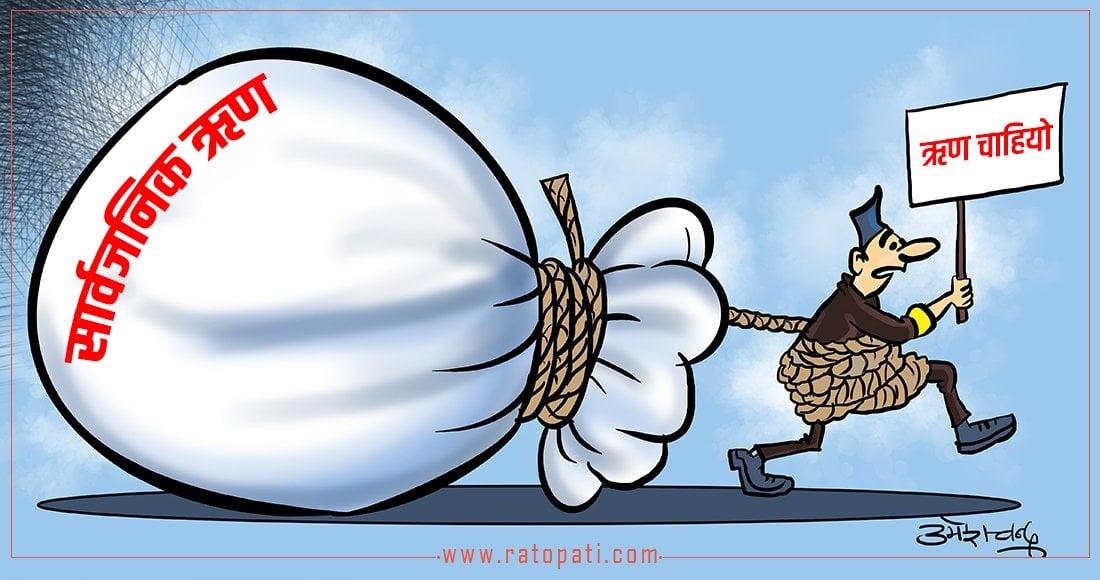Public Debt: Is Nepal facing a critical risk?

Kathmandu, September 15 — For the current fiscal year 2081/82, the government has set a target to borrow NPR 5.47 trillion. This includes NPR 2.17 trillion in external debt and NPR 3.30 trillion in domestic debt, as outlined in the current budget.
As of the end of the previous fiscal year 2080/81, Nepal’s public debt had exceeded NPR 24.33 trillion, approximately 43% of the country’s Gross Domestic Product (GDP). The total public debt comprises 51.47% external debt and 48.53% internal debt.
According to the Public Debt Management Office, the government paid NPR 2.43 trillion in debt principal and interest in the last fiscal year. For the current fiscal year, NPR 3.52 trillion has been allocated for development-related capital expenditures. This indicates that the increasing pressure of public debt is leading to a situation where spending on development and debt servicing is becoming similar.
While mandatory expenditures such as salaries and social security benefits are rising, the government faces mounting pressure to service old debt. Additionally, revenue collection has not met targets in recent years. Mahesh Bhattarai, Under Secretary at the Ministry of Finance, said, “The reduction in revenue and the increase in mandatory expenditures have made management more challenging, necessitating borrowing.”
Public debt doubled over the past few years, rising from NPR 1.048 trillion in fiscal year 2075/76 to over NPR 24 trillion now. According to Bhattarai, the increase in public debt is a result of significant spending on earthquake reconstruction and reduced revenue collection due to the COVID-19 pandemic. The maturity of internal debt securities and the subsequent need for repayment have also contributed to increased expenditures.
Economist Prof. Achyut Wagle acknowledges that borrowing is a standard economic practice and necessary, but the current pace of debt accumulation is concerning. He suggests that immediate corrective measures are needed to address the government's indiscriminate borrowing and spending practices.
While it is natural for governments to borrow to support their economies, the key question is how effectively this debt is used. Investments should ideally boost productivity, increase revenue, create job opportunities, and contribute to economic growth. However, experts point out that in Nepal, there is a risk of misallocation of funds, with loans used for non-productive expenses rather than investment in projects that yield economic returns.
According to the Public Debt Management Office, concessional loans from the International Monetary Fund (IMF) and the Belgian government do not require interest payments, and loans from the Exim Bank of China have interest rates below 2%. The World Bank, Nepal's largest lender, offers loans at an interest rate of 0.75%, while the Asian Development Bank provides loans at rates between 1% and 1.5%.
In contrast, domestic debt carries higher costs, with interest rates ranging from 3% to 5%, and shorter repayment periods of up to 9 or 10 years. Former Finance Minister Dr. Prakash Chandra Lohani highlights that the competitive and politically driven allocation of funds for public programs, rather than essential projects, has increased risks. He notes that while Nepal is not yet at a critical stage of debt risk, the space for borrowing is shrinking as the government faces growing challenges in managing its debt obligations.
The discrepancy between debt targets and actual borrowing underscores the need for better budget planning and execution. Experts argue that unrealistic budget estimates and targets are often set, leading to significant gaps between projections and actual figures. Dr. Lohani emphasizes that this highlights issues with budget formulation and allocation.









Leave Comment